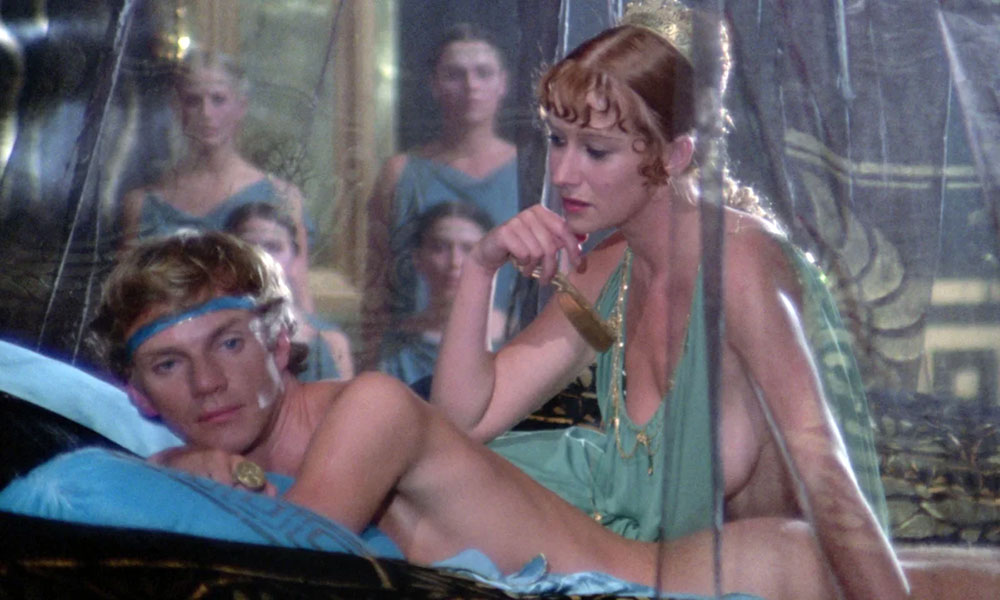If you’ve ever seen, or even heard about Caligula (1979), chances are it’s the Penthouse impresario Bob Guccione’s version, the historical drama with all the sucking and fucking, and very little in the way of historical drama. And unless you were part of the unsuspecting filmgoing audience that lined up to empty the theaters in 1980, placing the film just under Raging Bull (1980) at that year’s global box office, there’s a good chance that’s why you watched it—the allure of a film so shocking, vile, and morally reprehensible that it had to be screened in specially rented arthouses in order to avoid both the MPAA’s dreaded “X” rating and relegation to the porn-theater circuit. It is a film so unrepentantly violent and horny that it made the Italian auteur Tinto Brass’s previous film, the Nazisploitation epic Salon Kitty (1975), look restrained in comparison. It not only lost the blessing of its screenwriter, Gore Vidal, at the start of production, but also of Brass himself by the time of its release.
As it stands, Caligula is a film defined by its relationship to extremity, with audiences and critics alike over the last few decades christening it the worst film ever made—on grounds of taste, morality, or both. Now, a “complete reconstruction” of the film threatens to challenge that vaunted title by restoring it to something more akin to Brass’s (and Vidal’s) original intentions. Caligula: The Ultimate Cut, which debuted last year at Cannes and begins its re-release in select theaters on August 16 via Drafthouse Films, is nothing short of a total overhaul. Gone are the considerable forays into unsimulated, Roman-themed sex between Penthouse Pets; gone is the feeling that the film is a series of loosely-connected vignettes featuring the Fremen-eyed Malcolm McDowell as the titular emperor gallivanting and braying about elaborate backdrops in increasingly monotonous fits of unchecked madness; gone too is the danger, that naughty feeling of a marketing coup successfully executed by Guccione and his team of porn editors. What remains, however, is undoubtedly a more respectable version of the film and, were it not for a few indelible scenes of extreme hedonism, humiliation, and depravity, this would be the Caligula you could show in history classrooms.
Much of this is to the credit of film historian and producer Thomas Negovan, the architect of The Ultimate Cut, who pieced together an entirely new version of the film using a recently discovered treasure trove containing over 100 hours of original footage. I always liked the original, which was brazen and unabashedly flawed on pretty much every level—structural, cinematic, ideological. Its release and subsequent disavowal felt like an unanswered provocation toward Western moralists. What’s more objectionable: unsimulated sex or simulated violence?
Today, with the Caligulan appetite of numerous politicians, celebrities, and former members of PayPal’s inner circle going unchecked, the film’s supposed thesis—that “absolute power corrupts absolutely,” to quote the Boston Municipal Court verdict that allowed the film to pass the United States’ three-prong obscenity test—feels obvious, rendering Brass and Guccione’s pure-hearted commitments to formal and visual excess more interesting than Vidal’s intended message. On the one hand, The Ultimate Cut is a time capsule of sharp edges, like a damaged Augustan statuary of the 1970s. On the other, for its successful commitment to narrative consistency, copious amounts of never-before-seen footage, and the simple fact that it’s just more Caligula, The Ultimate Cut is a multi-textured curiosity for fans of historical epics and erotic spectaculars alike. We Caligula fans are “more is more” people after all. As the emperor himself says, when asked if he prefers nymphs or satyrs: “I like both.”
Caligula: The Ultimate Cut screens this evening, August 16, and throughout the weekend, at IFC and Alamo Drafthouse Manhattan.



